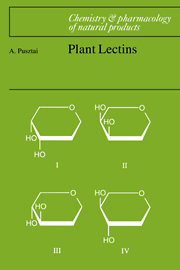5 - Effects on blood cells
Published online by Cambridge University Press: 05 February 2012
Summary
The realization made almost simultaneously by Boyd (Boyd & Reguera, 1949) and Renkonnen (1948) that some plant lectins are blood group-specific has done more than any other to turn the studies of lectins from an interesting, though somewhat esoteric field of study into a major and multidisciplinary science. Thus, Nowell discovered in 1960 that preparations of a lectin from the seeds of Phaseolus vulgaris (PHA) have strong mitogenic activity on peripheral lymphocytes (Nowell, 1960). Not long after this, Aub and his colleagues recognized by a chance observation that some transformed cells have greater affinity for lectins than the cell lines from which they originate (Aub, Tieslau & Lankester, 1963). Obviously, both these important effects are the result of specific reactions between cell surface carbohydrate structures and the appropriate lectins. This initial specific recognition of and binding to cell surface receptors by lectins occurs both in vivo and in vitro and has wide-ranging and dramatic effects on cells.
These two major discoveries led to an upsurge of research activity by scientists from all fields of biological sciences, particularly, cell biologists interested in immunology and cancer research. As the composition and the physical state of the cell surface is known to change throughout the life-cycle of the cell and to alter radically during cancerous or precancerous transformation, it is not surprising to find that lectins, which can specifically recognize such surface receptors, are exploited as welladaptable and excellent tools for monitoring and studying these changes.
Agglutination
Agglutination is one of the most characteristic and important reactions of those plant lectins which have at least two carbohydrate-binding sites.
- Type
- Chapter
- Information
- Plant Lectins , pp. 74 - 104Publisher: Cambridge University PressPrint publication year: 1992

